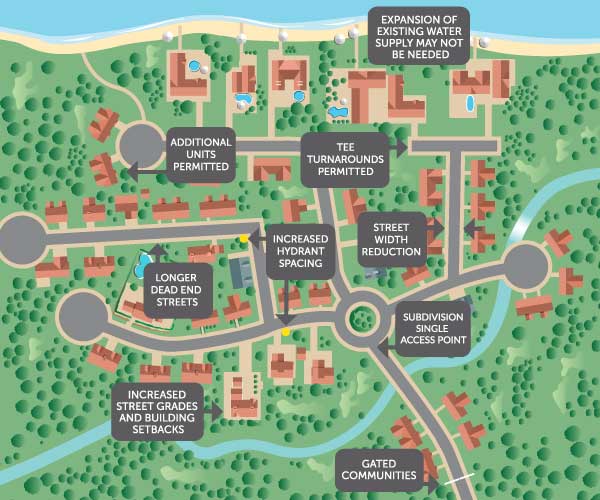Fire Sprinkler Trade-Ups for Builders
Trade-ups are Good for Developers, Homeowners and Communities
 Trade-ups can increase fire safety, control municipal operating expenses and lower construction costs. The best time to take advantage of the trade-up concept for subdivision development savings is prior to submitting subdivision plans. When proper subdivision and development options are provided, development costs can be reduced. Sprinklered developments provide an excellent opportunity to provide increased fire safety.
Trade-ups can increase fire safety, control municipal operating expenses and lower construction costs. The best time to take advantage of the trade-up concept for subdivision development savings is prior to submitting subdivision plans. When proper subdivision and development options are provided, development costs can be reduced. Sprinklered developments provide an excellent opportunity to provide increased fire safety.
The cost of developing raw land into an approved building site can be significantly reduced through trade-ups. These options are only applicable if all the buildings in the development will have built-in automatic fire protection.
Including fire sprinklers in all new construction is a win-win decision. The community has additional fire protection without higher taxes or increased insurance rates. The developer can reduce land development costs. The builder can reduce construction costs. And the buyer will have increased life and property protection at a lower cost.
For more information go to our Builder Incentives Resources page.
Incentives include:
In jurisdictions without home fire sprinkler code requirements, AHJs can work with planners, builders and developers to provide cost-saving trade ups or incentives when the entire development is protected with home fire sprinklers.
Trade ups or incentives often allow better utilization of land and infrastructure cost savings. They can include:
Street-Width Reduction—Traffic lanes may be narrowed, substantially reducing the amount of pavement in every linear foot of street in the development.
Longer Dead-End Streets—Dead-end streets may be increased in length, allowing additional building lots to be accessed.
Tee Turnarounds Permitted—The permitted use of tee turnarounds in sprinklered developments can create at least one additional lot per cul-de-sac.
Increased Street Grades and Building Setbacks—Steeper street grades and building locations allowed further from where the homes access leaves the main road.
Additional Units Permitted—Development plans that allow homes to be closer together.
Expansion of Existing Water Supply May Not Be Needed—Required fire flows for fully sprinklered developments can be greatly reduced compared to non-sprinklered developments.
Increased Hydrant Spacing—Supply mains may be reduced and hydrant spacing can be increased.
Subdivision Single Access Point—A fully sprinklered subdivision allows for a single public access road. This decreases infrastructure costs and significantly increases the number of single family dwellings allowed.
Gated Communities—Gated communities can delay Fire Department Access. A fully sprinklered subdivision provides mitigation for this impact allowing developers to utilize this security option when desired.
Reduced Basement Windows—Fire sprinklers reduce rescue openings in every basement sleeping room.